
Concept explainers
(a)
Interpretation: The products formed by the treatment of D-altrose with
Concept introduction: The
Answer to Problem 28.51P
The products formed by the treatment of D-altrose with
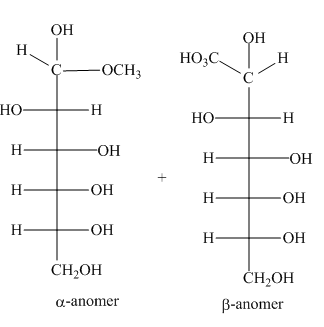
Explanation of Solution
The
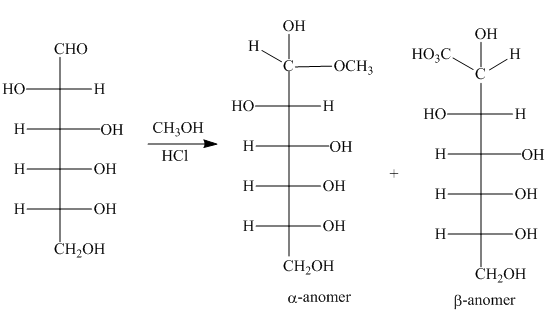
Figure 1
The products formed by the treatment of D-altrose with
(b)
Interpretation: The products formed by the treatment of D-altrose with
Concept introduction: The
Answer to Problem 28.51P
The products formed by the treatment of D-altrose with
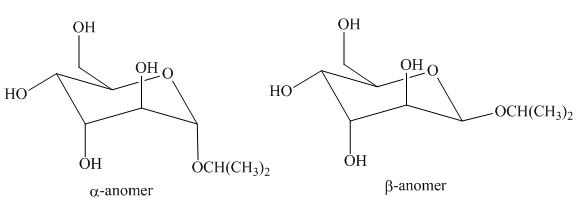
Explanation of Solution
The
The products formed by the treatment of D- altrose with

Figure 2
The products formed by the treatment of D-altrose with
(c)
Interpretation: The products formed by the treatment of D-altrose with
Concept introduction: The substitution reaction involves the replacement of one
Answer to Problem 28.51P
The product formed by the treatment of D-altrose with
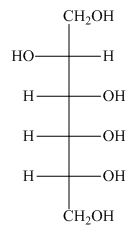
Explanation of Solution
The product formed by the treatment of D-altrose with

Figure 3
In the given reaction, sodium borohydride is used as a reducing agent. Sodium borohydride is used to for the reduction of carbonyl compounds to alcohols.
The product formed by the treatment of D-altrose with
(d)
Interpretation: The products formed by the treatment of D-altrose with
Concept introduction: The aldehyde group of aldoses oxidizes to carboxyl group on treatment with
Answer to Problem 28.51P
The product formed by the treatment of D-altrose with
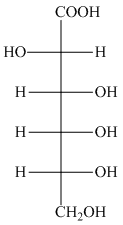
Explanation of Solution
The oxidation of aldehyde group of aldoses leads to the formation of aldonic acid, in which the terminal carbon atoms are substituted by carboxyl group and alcoholic group. The product formed by the treatment of D-altrose with
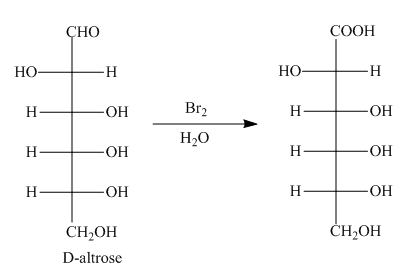
Figure 4
The product formed by the treatment of D-altrose with
(e)
Interpretation: The products formed by the treatment of D-altrose with
Concept introduction: The aldehyde group and primary alcohol of aldoses oxidizes to carboxyl groups on treatment with warm
Answer to Problem 28.51P
The product formed by the treatment of D-altrose with
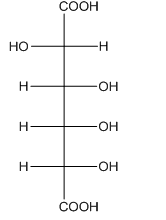
Explanation of Solution
The oxidation of aldehyde group and primary alcohol of aldoses leads to the formation of aldaric acid, in which the terminal carbon atoms are substituted by carboxyl groups. The product formed by the treatment of D-altrose with
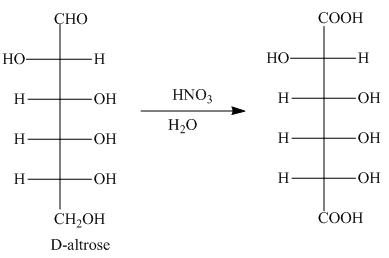
Figure 5
The product formed by the treatment of D-altrose with
(f)
Interpretation: The products formed by the treatment of D-altrose with [1]
Concept introduction: The
Answer to Problem 28.51P
The product formed by the treatment of D-altrose with [1]

Explanation of Solution
The reaction of D-altrose with hydroxylamine results in the formation of oxime. The second step is the dehydration of oxime to nitriles. The reaction of nitrile with
The product formed by the treatment of D-altrose with [1]
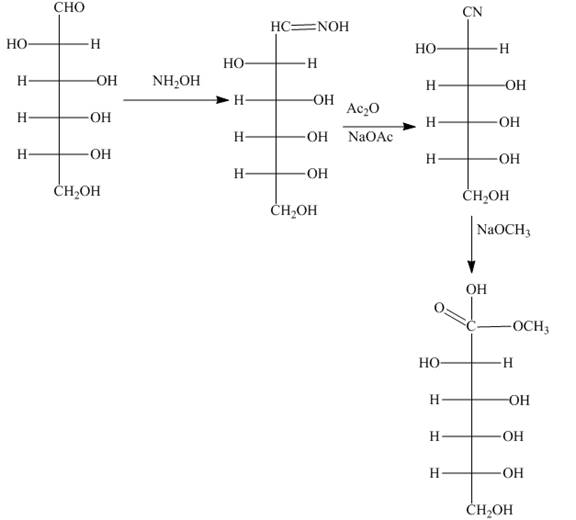
Figure 6
The product formed by the treatment of D-altrose with [1]
(g)
Interpretation: The products formed by the treatment of D-altrose with [1]
Concept introduction: The
Answer to Problem 28.51P
The products formed by the treatment of D-altrose with [1]
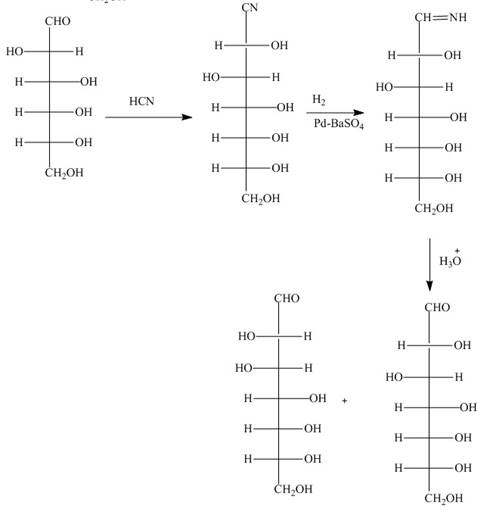
Explanation of Solution
The products formed by the treatment of D-altrose with [1]
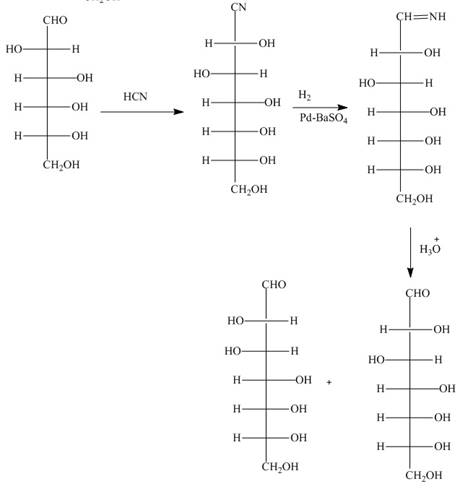
Figure 7
The products formed by the treatment of D-altrose with [1]
(h)
Interpretation: The products formed by the treatment of D-altrose with
Concept introduction: The
Answer to Problem 28.51P
The products formed by the treatment of D-altrose with
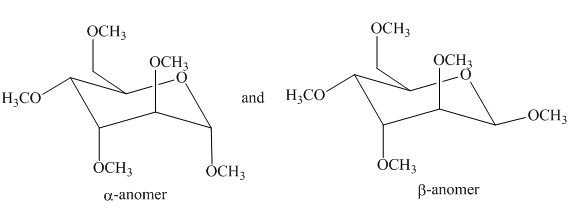
Explanation of Solution
The

Figure 8
The products formed by the treatment of D-altrose with
(i)
Interpretation: The products formed by the treatment of D-altrose with
Concept introduction: The
Answer to Problem 28.51P
The products formed by the treatment of D-altrose with
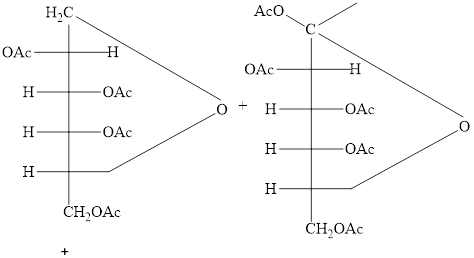
Explanation of Solution
The
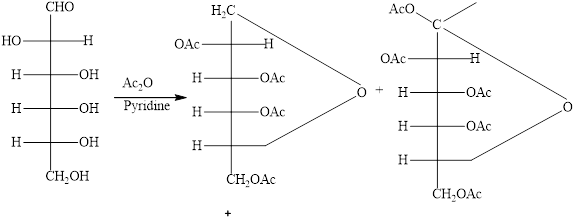
Figure 9
The products formed by the treatment of D-altrose with
(j)
Interpretation: The products formed by the treatment of D-altrose with
Concept introduction: The
Answer to Problem 28.51P
The products formed by the treatment of D-altrose with

Explanation of Solution
The

Figure 10
The products formed by the treatment of D-altrose with
Want to see more full solutions like this?
Chapter 28 Solutions
Organic Chemistry
- Predict the major products of this organic reaction: H OH 1. LiAlH4 2. H₂O ? Note: be sure you use dash and wedge bonds when necessary, for example to distinguish between major products with different stereochemistry. Click and drag to start drawing a structure. G C टेarrow_forwardFor each reaction below, decide if the first stable organic product that forms in solution will create a new C-C bond, and check the appropriate box. Next, for each reaction to which you answered "Yes" to in the table, draw this product in the drawing area below. Note for advanced students: for this problem, don't worry if you think this product will continue to react under the current conditions - just focus on the first stable product you expect to form in solution. NH2 CI MgCl ? Will the first product that forms in this reaction create a new CC bond? Yes No MgBr ? Will the first product that forms in this reaction create a new CC bond? Yes No G टेarrow_forwardFor each reaction below, decide if the first stable organic product that forms in solution will create a new CC bond, and check the appropriate box. Next, for each reaction to which you answered "Yes" to in the table, draw this product in the drawing area below. Note for advanced students: for this problem, don't worry if you think this product will continue to react under the current conditions - just focus on the first stable product you expect to form in solution. དྲ。 ✗MgBr ? O CI Will the first product that forms in this reaction create a new C-C bond? Yes No • ? Will the first product that forms in this reaction create a new CC bond? Yes No × : ☐ Xarrow_forward
- Predict the major products of this organic reaction: OH NaBH4 H ? CH3OH Note: be sure you use dash and wedge bonds when necessary, for example to distinguish between major products with different stereochemistry. Click and drag to start drawing a structure. ☐ : Sarrow_forwardPredict the major products of this organic reaction: 1. LIAIHA 2. H₂O ? Note: be sure you use dash and wedge bonds when necessary, for example to distinguish between major products with different stereochemistry. Click and drag to start drawing a structure. X : ☐arrow_forwardFor each reaction below, decide if the first stable organic product that forms in solution will create a new C - C bond, and check the appropriate box. Next, for each reaction to which you answered "Yes" to in the table, draw this product in the drawing area below. Note for advanced students: for this problem, don't worry if you think this product will continue to react under the current conditions - just focus on the first stable product you expect to form in solution. NH2 tu ? ? OH Will the first product that forms in this reaction create a new CC bond? Yes No Will the first product that forms in this reaction create a new CC bond? Yes No C $ ©arrow_forward
- As the lead product manager at OrganometALEKS Industries, you are trying to decide if the following reaction will make a molecule with a new C-C bond as its major product: 1. MgCl ? 2. H₂O* If this reaction will work, draw the major organic product or products you would expect in the drawing area below. If there's more than one major product, you can draw them in any arrangement you like. Be sure you use wedge and dash bonds if necessary, for example to distinguish between major products with different stereochemistry. If the major products of this reaction won't have a new CC bond, just check the box under the drawing area and leave it blank. Click and drag to start drawing a structure. This reaction will not make a product with a new CC bond. G marrow_forwardIncluding activity coefficients, find [Hg22+] in saturated Hg2Br2 in 0.00100 M NH4 Ksp Hg2Br2 = 5.6×10-23.arrow_forwardgive example for the following(by equation) a. Converting a water insoluble compound to a soluble one. b. Diazotization reaction form diazonium salt c. coupling reaction of a diazonium salt d. indacator properties of MO e. Diazotization ( diazonium salt of bromobenzene)arrow_forward
- 2-Propanone and ethyllithium are mixed and subsequently acid hydrolyzed. Draw and name the structures of the products.arrow_forward(Methanesulfinyl)methane is reacted with NaH, and then with acetophenone. Draw and name the structures of the products.arrow_forward3-Oxo-butanenitrile and (E)-2-butenal are mixed with sodium ethoxide in ethanol. Draw and name the structures of the products.arrow_forward
 ChemistryChemistryISBN:9781305957404Author:Steven S. Zumdahl, Susan A. Zumdahl, Donald J. DeCostePublisher:Cengage Learning
ChemistryChemistryISBN:9781305957404Author:Steven S. Zumdahl, Susan A. Zumdahl, Donald J. DeCostePublisher:Cengage Learning ChemistryChemistryISBN:9781259911156Author:Raymond Chang Dr., Jason Overby ProfessorPublisher:McGraw-Hill Education
ChemistryChemistryISBN:9781259911156Author:Raymond Chang Dr., Jason Overby ProfessorPublisher:McGraw-Hill Education Principles of Instrumental AnalysisChemistryISBN:9781305577213Author:Douglas A. Skoog, F. James Holler, Stanley R. CrouchPublisher:Cengage Learning
Principles of Instrumental AnalysisChemistryISBN:9781305577213Author:Douglas A. Skoog, F. James Holler, Stanley R. CrouchPublisher:Cengage Learning Organic ChemistryChemistryISBN:9780078021558Author:Janice Gorzynski Smith Dr.Publisher:McGraw-Hill Education
Organic ChemistryChemistryISBN:9780078021558Author:Janice Gorzynski Smith Dr.Publisher:McGraw-Hill Education Chemistry: Principles and ReactionsChemistryISBN:9781305079373Author:William L. Masterton, Cecile N. HurleyPublisher:Cengage Learning
Chemistry: Principles and ReactionsChemistryISBN:9781305079373Author:William L. Masterton, Cecile N. HurleyPublisher:Cengage Learning Elementary Principles of Chemical Processes, Bind...ChemistryISBN:9781118431221Author:Richard M. Felder, Ronald W. Rousseau, Lisa G. BullardPublisher:WILEY
Elementary Principles of Chemical Processes, Bind...ChemistryISBN:9781118431221Author:Richard M. Felder, Ronald W. Rousseau, Lisa G. BullardPublisher:WILEY





